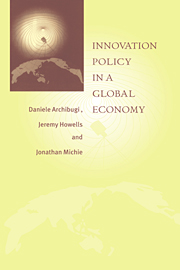Book contents
- Frontmatter
- Contents
- List of figures
- List of tables
- List of contributors
- Foreword
- Preface and acknowledgements
- 1 Innovation systems and policy in a global economy
- Part I National systems of innovation
- Part II Regional, national and global forces
- 5 Regional systems of innovation?
- 6 Global corporations and national systems of innovation: who dominates whom?
- 7 Globalisation and financial diversity: The making of venture capital markets in France, Germany and UK
- 8 Patterns of national specialisation in the global competitive environment
- Part III Globalisation and economic performance
- Index
8 - Patterns of national specialisation in the global competitive environment
Published online by Cambridge University Press: 05 November 2009
- Frontmatter
- Contents
- List of figures
- List of tables
- List of contributors
- Foreword
- Preface and acknowledgements
- 1 Innovation systems and policy in a global economy
- Part I National systems of innovation
- Part II Regional, national and global forces
- 5 Regional systems of innovation?
- 6 Global corporations and national systems of innovation: who dominates whom?
- 7 Globalisation and financial diversity: The making of venture capital markets in France, Germany and UK
- 8 Patterns of national specialisation in the global competitive environment
- Part III Globalisation and economic performance
- Index
Summary
Introduction
National environments differ in their capability of stimulating, facilitating or preventing innovative activities of firms, and historically national economies and their institutional set-up have had a considerable influence on the firms' competitive success. A vast recent literature by formulating the concept of the ‘national system of innovation’ has confirmed that the structural characteristics of a national economy, such as its specific production structure, its technical infrastructure and other institutional factors, can strongly influence firms' innovative performances (Freeman and Soete, 1997; Lundvall ed., 1992; Nelson ed., 1993; Edquist ed., 1997). It has been shown that differences in national systems are particularly important between the United States, Japan and the EU, and between the European countries themselves.
The concept of national specificities determining national performance, however, has been recently challenged on the grounds that the current wave of globalisation and sophistication of financial markets are aligning national economies. The growing role of transnational corporations (TNCs) in the current global competitive phase, as many point out, is changing the face of the world economy in the direction of standardisation and convergence of national structures and performances. A few even predict that the nation state will soon be obsolete and that national diversities, that were very important in the past, are likely to disappear in the near future. The limiting case would be of a fully transnational economy without any residual disparities across countries (Ohmae, 1990).
This chapter assesses the issue of the linkage between globalisation and national specificities by looking at the dynamics of world trade and trade specialisation of major economies. It is divided into four sections.
- Type
- Chapter
- Information
- Innovation Policy in a Global Economy , pp. 139 - 160Publisher: Cambridge University PressPrint publication year: 1999
- 12
- Cited by



